In their latest Diwali campaign, Candere by Kalyan Jewellers has caused a stir around the negative catchphrase #BaateinTohHongiHi by beautifully reshaping the sentiment into a positive emotion.
The advertisement highlights the boldness of the brand and its self-assured confidence which it flaunts. The theme of the advertisement is around an older woman and a young man in a relationship which causes tongues to wag in their circle. The couple is happy and secure and is beyond what others think or feel. The analogy with the brand is drawn from the fact that if you are extraordinary, it is bound to make heads turn and start conversations. Candere, from KalyanJewellers, makes a similar statement. It has designs to suit everyone, irrespective of their age and tastes and its unique designs spell class.
It is usual for people to comment when someone does not behave in the ‘expected’ way and decides to carve their own path. Those who dare to be different follow their own heart and fashion their own rules.
Baateintohhongi hi usually has a negative connotation in the Indian social context because people love to gossip or comment when someone doesn’t conform to societal norms or follow the standard convention. However, the campaign gives a positive twist to the old term by using it in the context of being so special that people sit around and talk about you.
The ad provokes the audience with this closing line ‘Jab aapmeinkuchbaathogi, tohbaateintohhongi hi’ bringing forth the idea that the nature of a rumor or gossip depends on how you react to it. The storyline revolves around an ‘odd’ couple with a noticeable age difference. While the age gap has not been much of a taboo where the man is older than the woman, the thought does not find the same acceptance in society when the situation is reversed. This story addresses the concern that a couple faces when ‘people talk’ and respond with wit and humor focusing on the perfect bond they share making the age gap look immaterial.
Commenting on the * #BaateinTohHongiHi campaign, Rupesh Jain, CEO, Candere said, ”The society has certain views and perceptions and those who don’t conform to rules face criticism. That does not reduce their stature. It only shows how they stand apart from the rest because they dare to be different and follow their own heart. Candere, as a brand endeavours to make its quality speak for itself. With every creation, Candere makes a fashion statement that is bold, different, and worth being talked about. We are quite excited about the campaign as we feel that it captures the essence of the Candere brand.”
AkshayMatkar who is extremely excited about the campaign said, “We have tried to make a bold statement here. It is time society changed its rigid views about acceptable behavior or preferences. Everyone has the right to follow their heart and do what makes them happy. Going with the flow is not necessary all the time. You can always choose to be different and do as your heart desires. People talking need not be construed as bad always. If you have the power to change a negative thought, act, or emotion into a positive one you will stand out and yes, you will get people talking.”
The director Rishabh Shrivastava from the ad agency Digital F5 said, “The idea stemmed from how we like to gossip about things that are unusual. And a very Indian colloquial phrase is log baateinkarrahehain. We thought, what if we turned this idea on its head. It was a great experience for me to translate my idea into a film with Suchitra Pillai and AmolParashar taking it up a notch. Being different is reason enough for people to talk and we have played on this point to highlight that Candere, as a brand, stands apart and deserves to be talked about. Being different or unconventional needs to be appreciated because it requires a lot of courage to stand up and follow your heart, no matter what others say. A good film is always the result of the client, the agency and the production being tuned to the same frequency. As was the case here. We loved working with Candere to derive this unique positioning, taking on ‘age gap’ as a cause.”
















